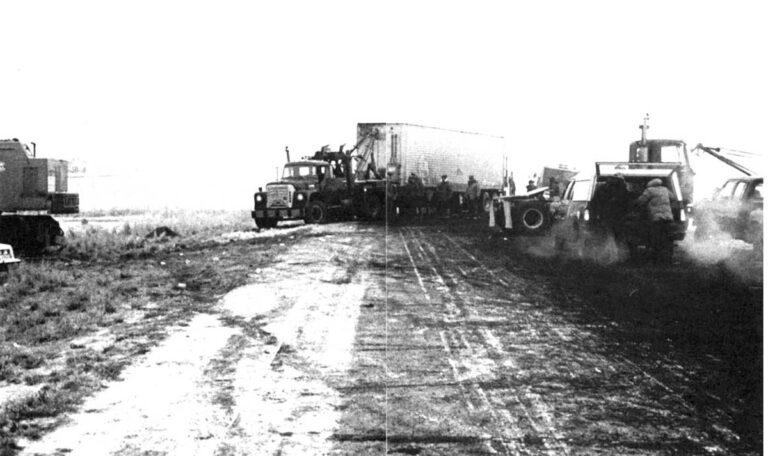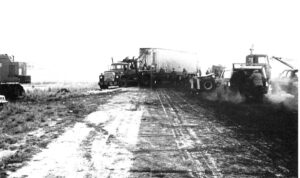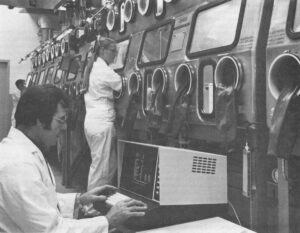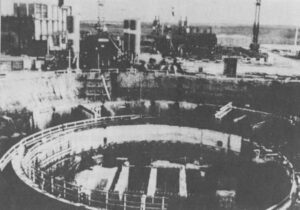DENVER–The temperature was in the 20’s this December day and light snow was expected as Jonny Sappington pulled his government-owned 18-wheeler out of Cheyenne after lunch. He headed south toward Denver with his highly classified cargo. Three heavily armed guards followed close behind in a light blue, unmarked Chevrolet Blazer. Two more armed men were in the tractor with him and shared the driving duties since the crew left Richland, Washington, early the previous day.
Despite the threatening forecast and overcast skies, the interstate was still clear and dry, at least for another 40 miles. As Sappington neared Fort Collins, Colorado, the condition of the road rapidly worsened. Fog hung in the low-lying areas along the highway, condensing and freezing – coating the pavement with a thick sheet of ice.
Sappington slowed his rig as he encountered the first large patch. Moments later, he spotted a truck that had overturned about 400 yards ahead. He applied his brakes and tried to avoid the obstruction, but his truck slowly jack-knifed and slid onto the median strip. The trailer tipped over and landed on its side in the ice-encrusted weeds.
So many vehicles skidded off the road that day the local office of the Colorado State Patrol was unable to respond to all the calls. Motorists were advised to come into the office when the weather cleared to fill out accident forms. Another overturned truck would hardly be noticed but this one was different. It contained a cargo of plutonium, the raw material of nuclear weapons.
For the next 18 hours, local officials and the media got a rare close-up look at one of the government’s more secretive operations: the transportation of nuclear warheads, unassembled bomb components and the nuclear ingredients used in the manufacture of these weapons. The disabled truck and its sensitive contents belonged to the U.S. Department of Energy, the agency responsible for developing, manufacturing and transporting the nation’s nuclear arsenal.

DOE’s transportation safeguards division based in Albuquerque operates a fleet of more than three dozen custom built “safe and secure trailers” (SST’s) like the one which skidded off the southbound lane of Interstate 25 with Sappington at the wheel. The division employs an elite force of 150 highly trained and heavily armed “couriers” to escort its shipments, most of them combat veterans recruited from the military services. Under the Atomic Energy Act of 1954, they are authorized to use whatever force is necessary to protect what they occasionally refer to as “the goodies.”
Last year, DOE’s convoys logged three and a half million miles while moving secret cargoes between 100 locations within the United States. The shipments routinely rolled over most of the interstate highways in the country and through most of the major cities. The nuclear ingredients and weapon components are transported almost continuously between the seven privately-operated plants and two government laboratories that form the heart of the manufacturing complex. The assembled bombs are delivered to, or retrieved from, more than 60 Air Force and Navy bases where nuclear weapons are stored or deployed.
A Thousand Shipments
So many shipments are made each year (probably more than a thousand) that DOE frequently has a dozen or more convoys on the roads simultaneously in all kinds of weather during all hours of the day and night. Through it all, the transportation safeguards division has maintained a remarkably low profile. From the outside its trucks are indistinguishable from the thousands of other unmarked rigs on the road. The DOE vehicles are specifically exempted from regulations requiring commercial shippers to identify radioactive or explosive cargoes. Only the government license plates provide a slight hint as to the nature of the shipment. A trained observer might also notice that these trucks are far heavier than most on the road, a result of extensive armor plating and structural reinforcement that DOE officials liken to a bank vault on wheels.
Though SST’s usually go unrecognized by the millions of travellers who pass them on the highways, the accident near Fort Collins last December marked one of the very few instances in which such a nuclear ship was identified publicly.
Within seconds after the accident, Robert Walton, the small wiry commander of the six-person escort team, posted guards around the trailer. The plainclothes couriers would have been easily mistaken for commercial truckers without the M-16 automatic rifles and the badges which identified them as federal officers. People who stopped to help were quickly ordered to move on. Also within moments, Walton established direct contact with his headquarters in Albuquerque on the sophisticated high-frequency radio equipment carried by the convoy.
Another courier checked the area with a hand-held radiation detector, then worked his way over the surfaces of the trailer to verify that there had been no leakage of radioactive material. (The escort team couldn’t simply open the trailer and examine the contents. Couriers are not informed of the procedures for unscrambling the electronically-coded locks
on the vault within.) Despite the impact of the accident, the SST was undented, evidence of the structural strength of the vehicle.
As state police closed the highway and diverted traffic to a frontage road, DOE officials in Albuquerque made arrangements to retrieve their valuable cargo. A hastily-assembled 45-man team was dispatched from Warren Air Force Base near Cheyenne to provide additional security and assist in the recovery.
Robert Walton read a brief prepared statement for reporters who arrived on the scene. His typed script, presumably kept on hand for such emergencies, described the contents only as a “classified shipment” that was “not affected by the accident” and “did not pose any danger to the public:’
The Air Force crew worked throughout the night, hindered by snow and ice. Nervous young airmen huddled in pick-up trucks with their rifles and shotguns, trying to keep warm as they peered into the darkness. Finally, by daybreak, the SST was on the road again, headed back to Warren Air Force Base instead of the original destination, a plutonium factory at the Los Alamos Scientific Laboratory in northern New Mexico. A truck-mounted crane and three heavy-duty tow trucks were required to get the trailer upright.
The Weakest Link
Transportation of nuclear materials has always been shrouded in secrecy. As the science and technology of building nuclear weapons have become more widely known, the U.S. government has turned to tighter physical security to keep the essential raw materials out of the hands of its adversaries. On paper at least, these defenses are weakest and the material is most vulnerable to theft when it is being moved. That is the time when it is furthest from secure installations and protected by the fewest people.
In the early days of the nuclear age, the heaviest security was applied to vital information and assembled weapons, not the raw materials. In 1943 the physicist Glenn Seaborg packed one of the first microscopic specks of the man-made element plutonium in a vial in his suitcase and carried it with him from Berkeley to the secret wartime laboratory at Los Alamos where the feasibility of building an atomic bomb was being studied. A year later, when large quantities of enriched uranium had to be moved from Oak Ridge, Tennessee to Los Alamos, the Army organized the first system of nuclear couriers. Soldiers in civilian clothes travelled by commercial train to Chicago and then to New Mexico with the uranium concealed in ordinary luggage.
During the 1950s, as the old Atomic Energy Commission sought to encourage the development of a private nuclear industry, the transportation of weapons-grade plutonium and uranium was entrusted to government contractors and commercial carriers. The AEC reasoned that the high intrinsic value of the substances and the prospect of heavy financial losses would provide adequate incentive for the contractors to protect the nuclear material in their possession.
By the mid-1960s, however, numerous critics inside and outside the AEC were questioning this logic, especially in light of rising terrorist activity around the world. It was only a matter of time, they argued, before terrorists might try to obtain a nuclear weapon. In response, the agency slowly began to order tougher security measures at its facilities and started work on an improved transportation system.
The deceptively simple concept underlying the present system was set forth in the early 1970s. The original plan was to build a nearly impregnable shipping container that could be easily immobilized if necessary. It would be made of the most resistant steel. Ideally, the device would be impossible for even well-equipped thieves to crack, pry or blast open for many hours, if not days. The second part of the plan called for a highly reliable nationwide communications system to keep track of the containers at all times under all conditions. In the event of an attack against a shipment, reinforcements could be moved to the scene before the perpetrators breached the protective layers of the shipping container.
By 1972, the AEC had its first ten “safe and secure trailers” and its secure communications network (“SECOM”) in operation while still using commercial carriers for many of its shipments. Then came the shock of the Summer Olympics in Munich.
The murder of eleven Israeli athletes by the Black September terrorist group stunned security planners at the highest levels of the Western governments. The event forced the realization that terrorism had become much harder to control or even to predict. In the U.S., President Richard Nixon appointed a cabinet-level committee to combat terrorism. One result was an expensive program to strengthen the defenses against the theft of nuclear material. Scientists quickly jumped from the question of whether terrorists would acquire nuclear weapons to consideration of when and where and how.
In the aftermath of Munich, the AEC ordered the expansion of its transportation system to cover not just finished nuclear weapons, but all material that could be used to build an illicit bomb. Private shipments were ended in 1974.
SECOM Center
These days, the AEC is gone, broken up in a governmental reorganization. Its Albuquerque Operations Office, which supervised the production of nuclear weapons, is now part of the Department of Energy. Albuquerque Operations still occupies the same inconspicuous quarters within a small fenced compound on Kirtland Air Force Base east of the city. The offices are located in five white concrete buildings that once served as barracks for an anti-aircraft battalion. Across the street there is a base housing area of closely spaced one-family homes. Two blocks away children play in the dusty yard of the elementary school.
Hidden in the basement of one of the office buildings is the windowless command post where nuclear shipments are tracked as they move around the country. Only a handlettered cardboard sign on the locked door identifies the vital “SECOM Center. “
In an adjacent building, James P. Crane, the director of the transportation division talked about SECOM, his couriers and their secretive work. Officials like “Pat” Crane observe a delicate balance in discussing these matters. By saying too much thay could inadvertently release information useful to potential hijackers. But saying nothing also has risks. Such a policy would do little to reassure the public about the reliability of the safeguards. Complete silence also might open the door to foolish adventurism by those ignorant of the defenses.
Crane flatly asserts that anyone attempting to steal one of his shipments will fail and will probably be killed. His couriers are all in top physical condition and are required to stay that way. They’re proficient with shotguns, rifles, handguns and grenade launchers and must prove it periodically. They’ve rehearsed their roles in realistic combat exercises. And they’re well paid for their services; although the base pay for a new courier is about $14,000, most are earning $25,000-30,000 because of the heavy overtime that goes with the long hours on the road.
The average age of the couriers is 36. The youngest is 21 and the oldest are in their 60’s like Robert Walton. Turnover is very low and competition for vacancies is intense. The last class of 18 recruits was selected from 165 applicants. At the moment, DOE is not hiring.
Crane gives fewer details about the “safe and secure trailers. ” The SST’s now cost about one-third of a million dollars apiece, roughly three times the price of a standard heavy-duty tractor and trailer without all the specialized armor and defensive systems. The government rigs are crammed with tamper-proof gadgets to slow the progress of attackers until reinforcements arrive. These devices have been described as a series of explosives, gases and other debilitating booby-traps to surprise and confound hijackers. The vehicles can be rendered immobile, perhaps even by a remote radio signal. Official descriptions of these defensive systems are deliberately vague for security reasons. “We try to fuzz it up ‘ ” explains David Jackson, the director of public affairs for DOE’s Albuquerque Operations Office.
SECOM, Pat Crane contends, is now foolproof. The convoys transmit messages on four frequencies simultaneously to four widely separated relay stations. The redundancy decreases the chances that communications could be interrupted by power failures, sabotage or jamming. During a field test of SECOM in 1974, a convoy covered 10,000 miles on a roundabout trip through 31 states; the operator was able to contact the Albuquerque base on the first try 98 percent of the time. Since then, an improved system has been put into use and Crane says that he now has “100 percent contact.”
Of course, there are numerous other precautions in effect. Routes and shipment schedules are varied. Safe havens like military bases are available along the way if needed. Crews drive straight through to their destinations to get the cargo off the roads as quickly as possible. People are rotated between crews and assignments to counter the natural tendency for informal relaxation of procedures, or, worse, the opportunity for formation of an insider conspiracy.
The cost of the entire transportation operation is now about $17 million per year. The figure includes chartered rail shipments that are conducted in a manner almost identical to truck convoys. In the years ahead, Crane confidently predicts, his transportation division will grow larger. The U.S. has an estimated 30,000 nuclear weapons deployed around the world. (About 10,000 of these are “strategic” weapons in the megaton range, the kind that could be delivered by missiles or B-52’s to destroy Moscow. The rest are smaller “tactical” weapons in the kiloton range, many of them based in Western Europe.) The radioactive components of these weapons gradually decay and become less reliable, so they are replaced periodically. Consequently, DOE is moving thousands of nuclear weapons a year, even when the overall numbers in deployment remain constant. In addition, nuclear weapons must be brought back to the factory periodically for testing, modification or replacement by more advanced designs.
Pat Crane flatly says the country is entering a period when much more of this work will be done; shipments will increase. At the same time, he predicts that the transportation system is likely to remain very much as it is today. Probably it will become more computerized and will utilize new defensive gadgets that emerge from DOE’s ongoing research program, but no major revisions are anticipated.
Will the System be Untested?
The key question, of course, is whether the system is adequate.
Crane has no doubts. He proudly points out that his couriers have never been attacked and have never lost a gram of material entrusted to them. They have never even had an accident resulting in the release of radiation.
Well-informed independent evaluations on the adequacy of the system are virtually non-existent, however. Because the details of the operation are so highly classified, outsiders lack the information they need to perform a thorough analysis. A study commissioned by the Ford Foundation in 1971 considered a somewhat related issue, the possibility of theft of weapons-grade nuclear material from the U.S. nuclear power industry. In the final report, authors Mason Willrich and Theodore Taylor outlined the requirements for a transportation system tougher than those employed by the AEC for moving nuclear weapons at that time. DOE’s system today seems to exceed the measures recommended by Willrich and Taylor.
Still, DOE’s current procedures have never been subjected to the most realistic test of all: an actual assault by determined adversaries. Opinions on the performance of the system are based on simulations, training exercises and incidents like the overturned trailer outside Fort Collins last December. On that occasion, at least, everything appeared to work as intended. And the difficulty in recovering the SST indirectly confirmed an important feature of the system, the extraordinary effort and lengthy period necessary to move an immobilized nuclear shipment.
©1981 Ron Wolf
Ron Wolf is investigating the safeguarding of nuclear materials in the U.S.





